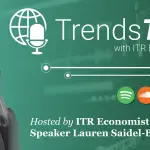WEEKLY FED WATCH
This week on Fed Watch, ITR Chief Economist Brian Beaulieu reviews the latest GDP data for 2Q24, which was stronger than anticipated. What is contributing to this strength in GDP, and which sectors are experiencing weakness? Tune in to find out!
Key Episode Takeaways
- 0:46 – Reviewing GDP data for 2Q24
- 2:35 – GDP increase helped by a rise in retail and wholesale inventories
- 3:08 – Analyzing consumer spending on goods
- 3:50 – Housing market data for 2Q24 showed significant weakness
- 5:57 – Contrasting data points for the Federal Reserve Board’s decision to lower interest rates
- 6:27 – ITR Economist Taylor St. Germain will be hosting Fed Watch in August
The below transcript is a literal translation of the podcast audio that has been machine generated by Notta.
I’m Brian Beaulieu. Welcome to this July 26th, 2024 edition of Fed Watch. It was a big week this week for data. And what grabbed the big headlines was the second quarter advanced number for GDP came out and it was stronger than we expected it was going to be. I can’t speak for the rest of the world. It was an average increase in GDP from 1Q to 2Q. And we thought it was going to be weaker than average. So that got us really curious. So we started tearing it apart.
And by the way, how much more than we expected. If you get our ITR trends report, for instance, the second quarter number came in 0.9% higher than the average of our forecast range. That puts it about 0.3% higher than what we thought would happen after the 1Q number came out. So it’s within forecast tolerances. In other words, it’s just it certainly wasn’t a weak number. It was stronger than than the average of our forecast range. So I tore that number apart this morning to trying to find out what was driving this, because clearly there’s implications for if the Fed is going to lower interest rates in September or at all, I suppose.
The number one driver of the increase in GDP, and I’m talking about adjusted for inflation when I talk about GDP, was personal consumption expenditures, consumer spending. But when you break that down, it was two to one services versus goods. And within the services, it was overwhelmingly increased housing and utility costs. We were spending more on rent. We were spending more on housing. We were spending more on utilities. And that was the number one driver for the increase in GDP.
So I understand why this considered a good. I’m just worried about consumers’ discretionary income, the potential pinch that implies in terms of their discretionary income. Health care was also up, so that’s a further impingement upon discretionary income. I don’t know if the Fed is going to see it that way or not.
The second largest reason and more important than goods was inventories going up. Retail and wholesale inventories rose a lot in the second quarter. I don’t consider that a real good sign, but the way GDP is calculated and the way it’s always been calculated, that’s called an investment, and that investment is counted as a plus. But I don’t like seeing inventory stocking up when retail sales outside of housing and utilities are sluggish.
The third largest component was in consumer spending for goods, and that overwhelmingly was motor vehicles and parts. We were buying cars in the second quarter, but we probably weren’t buying the luxury cars, and it seems like the trend is to buying the lower priced vehicles. So it was interesting numbers. It was consumer spending not in a discretionary way, and it was inventories being piled up that was driving a lot of that GDP strength in the second quarter. And all that, I told you it was about average, the first quarter, the second quarter change in GDP.
That stands in stark contrast to what we’re seeing, for instance, in the housing market. The June data is out for a single family housing permit, and that 1/12 for June was at minus 10.1 percent. That quarter to quarter change, except for the COVID years, you have to go back to the Great Recession years. And for that, you have to go back to 1980, and if you’re holding up like me, you remember that 1980 was a really tough period because, well, Arthur Burns was squeezing inflation out of the system by jacking up interest rates. Those are not great periods to be comparing to. Existing home sales were also not great. The 312 weakened a little bit. It had been in phase A. Now it’s back into maybe a phase D at minus 3 .3 percent, and that step two was more normal than negative, and it’s more normal. It was worse than what we saw last year, is how I should put it. And aside from the COVID years, you have to go back to the Great Recession housing debacle and the 1990 housing debacle. Mix the hair with the back of my neck, go up thinking about those years.
And new home sales worse than normal record bad for new home sales on the first quarter, the second quarter, we have never seen a drop like this in the second quarter of 2024, except for the COVID years. So maybe there’s more COVID ripple going on here. But folks, clearly these quarter to quarter changes in the housing market are a bellwether of some issues that will be rippling through the economy. Housing is a fairly good leading indicator. And the fact that the discretionary income was squeezed does not fill us with a lot of confidence here in the second half of the year where macroeconomic view we’re staying the course expect the conditions to generally weaken some more in the second half of the year this year.
But why you turned into FedWatch? What’s the Fed going to do with this? Gosh, I wish I knew if they just look at GDP, and they don’t want to raise lower interest rates, and they can just say, look, GDP held up, we don’t have to lower interest rates. But sure to shoot me if I was the Federal Reserve, and I had a vote, I’d be voting to lower those interest rates, because what’s going on in housing worries me. And I think it should worry them too.
For the next four Fed Watches, you are going to be treated to Taylor St. Germain taking my place in this seat. I am taking the month of August off. Europeans do it, it sounds like a great idea. Something I’ve been doing for years is taking August off. So Taylor is going to be taking my place. And this is going to give you a perfect opportunity to see the future. You know, Alan and I are winding down our careers. And Taylor is one of our stars. He’s the next generation that’s going to take ITR forward for decades. So I’m looking forward to you meeting Taylor. And I’ll see you all again in September. Thank you for watching this edition of FedWatch.


